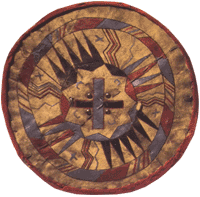





The Nez Perce are a tribe of Native Americans who inhabited the Pacific Northwest region of North America and adjoining regions at the time of the Lewis and Clark Expedition. Nez Perce is a misnomer given by the interpreter of the Lewis and Clark expedition at the time they first encountered the tribe in 1805. It is from the French, "pierced nose." This is an inaccurate description of the tribe. They did not practice nose piercing or wearing ornaments. The "pierced nose" tribe, though related to the Nez Perce, actually lived on and around the lower Columbia River, and in other areas of the Pacific Northwest.
The Nez Perce's name for themselves was Nee-me-poo, which means simply "the People." This is perhaps the most common self-designation of aboriginal peoples the world over.
The Nez Perce territory at the time of Lewis and Clark was approximately 17,000,000 acres (69,000 kmē). It covered parts of Washington, Oregon, and Idaho, in an area surrounding the Snake River and the Clearwater River. The Nez Perce, like many western Native American tribes, were migratory and would travel with the seasons, according to where the most abundant food was to be found at a given time of year. They were known go as far east as the Great Plains, hunting American Bison and fishing for salmon at Celilo Falls on the Columbia River. They relied heavily on quamash or camas gathered in the region between the Salmon and Clearwater River drainages as a food source.
Probably the best known leader of the Nez Perce was Chief Joseph, who led his people in their struggle to retain their identity in the face of American encroachments on their land.
The Nez Perce language is a branch of the Sahaptian family, which also includes several dialects of Sahaptin (note the spellings, -ian vs. -in). Together, these languages are grouped into the larger Penutian family, which also includes languages such as Cayuse, Klamath, and Chinookan. The organization of this linguistic family can be compared to often more familiar examples such as the Indo-European or Romance families, though presumably Penutian is in no way historically related to Indo-European languages.
